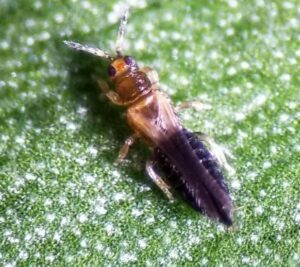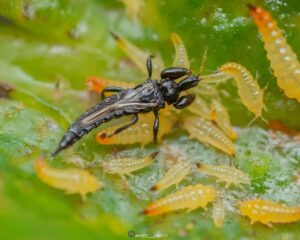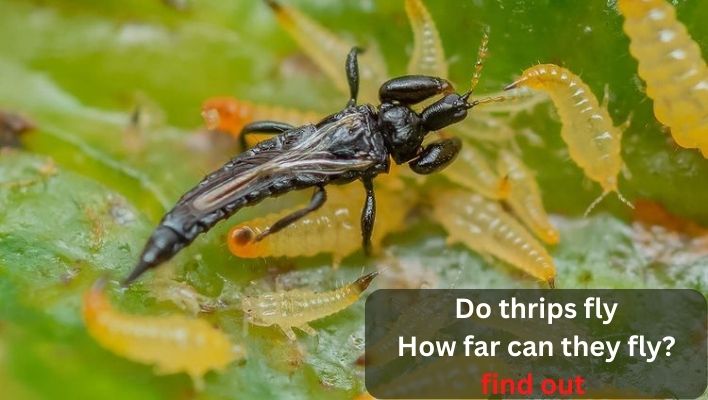Thrips are tiny, winged insects that can be major pests in gardens and farms. These insects are known for their destructive feeding habits, causing damage to leaves, flowers, and fruits. One question that often arises is whether or not thrips can fly.
Thrips are flying pesky pests around your garden, ruining your plants, and leaving behind unsightly damage. Many gardeners struggle with controlling these tiny insects.
In this blog post, we will explore the answer to this question and discuss the impact of thrips on plants and the various methods for controlling these pests.
Thrips Can fly
Thrips are small, slender insects ranging from 1/20 to 1/5 inch long. They have two pairs of wings and are typically brown or black. While thrips do have wings, not all species are capable of flying.
Some thrips, such as the Western flower thrips, are strong fliers and can easily move from plant to plant, spreading infestations quickly. However, other thrips species, such as the onion thrips, are poor fliers and tend to stay close to their host plants.
Thrips feed on plants using their sharp, rasping mouthparts to puncture plant cells and suck out the contents. This feeding can cause distorted growth, discoloration of leaves and flowers, and scarring on fruits and vegetables. Thrips can also transmit plant diseases, making them a significant threat to crops. So it is important to know how to get rid of them.
Overall, thrips can fly, but not all species are strong fliers. These tiny insects can cause significant damage to plants and crops, making them a major pest for farmers and gardeners. However, with proper monitoring and control methods, it is possible to manage thrips populations and protect your plants.

How far can thrips fly
Thrips are small, slender insects that belong to the order Thysanoptera. They are known for their ability to fly, but the distance they can fly can vary depending on several factors.
Generally, thrips can fly short distances, typically up to a few meters. However, they can also be carried by wind or other transportation, such as clothing or equipment, allowing them to travel long distances.
One important factor that affects the distance that thrips can fly is their size. Smaller thrips have a limited flying range, as they have less energy and are less able to withstand the wind. Larger thrips, on the other hand, have more power and are better able to fly longer distances.
Another factor that can affect the distance that thrips can fly is the wind. Strong winds can blow thrips great distances, while calm conditions limit their flying range. In addition, thrips are known to fly higher in the air when the wind is stronger, which can also affect the distance they can fly.
Thrips also use the wind to their advantage by “sailing” on the wind currents, which allows them to fly long distances without expending too much energy. This is known as passive dispersal, a common way for thrips to fly long distances.
In general, thrips can fly anywhere from a few meters to several kilometers, depending on the size of the thrips, the wind conditions, and their ability to “sail” on the wind currents.
Some thrips species have been known to fly up to 20 km daily. Their ability to fly makes them effective at spreading to new areas and colonizing new habitats.
Do all thrips fly
Not all thrips are capable of flying. Thrips are a diverse group of insects that belong to the order Thysanoptera, which includes over 6,000 species. These insects vary greatly in size, shape, and behavior, and some thrips are wingless, while others have functional wings.
Wingless thrips, also known as apterous thrips, cannot fly and are typically found on the undersides of leaves, flowers, and other plant surfaces. They are small and slender and use their mouthparts to feed on plant juices and other organic matter.
Winged thrips, also known as alate thrips, have functional wings and can fly. They are typically larger and more robust than wingless thrips and are often found on the upper surfaces of leaves, flowers, and other plant parts. Winged thrips use their wings to fly to new host plants, where they can feed and reproduce.
In some thrips species, only the females are winged, while the males are wingless. This is common in species that have a sedentary lifestyle and do not need to move to new host plants.
Overall, not all thrips fly, but some thrips species have functional wings and use them to fly. The species determine the ability to fly, and it can vary between males and females within the same species.

What do flying thrips look like
Flying thrips are small, slender insects typically around 1 to 2 millimeters in length. They have a characteristic elongated and slender body shape, with long, thin antennae and wings that are held flat over their backs.
The color of flying thrips can vary, but they are often yellow, brown, or black. They have two pairs of wings, with the front wings being thicker and more leathery than the rear wings. The wings are held flat over the body, giving the insect a streamlined appearance.
One of the most distinctive features of flying thrips is their long, thin legs. These legs are used for jumping and flying and are equipped with small claws that help the thrips cling to plants and other surfaces. The eyes of flying thrips are also large and prominent, giving them excellent vision.
In summary, flying thrips are small, agile insects easily recognizable by their slender body shape, elongated antennae, and thin, flat wings. They have a wide range of colors but are usually found in yellow, brown, or black.
Does fly spray kill thrips?
Fly spray, also known as an insecticide, can effectively kill thrips. The active ingredients in fly spray, such as pyrethrin or permethrin, are toxic to insects and can disrupt their nervous system, leading to death.
However, the effectiveness of fly spray in killing thrips may vary depending on the product and the infestation level. It is important to follow the instructions on the label and apply the product according to the recommended dosage to ensure optimal results.
Additionally, repeating the treatment may be necessary to eliminate the thrips population.
Best insecticide for thrips
Control of thrips can be challenging, as they can reproduce quickly and have a wide range of host plants. One method of control is to use sticky traps to monitor the population and detect an infestation early on. Another method is to use insecticides, but it is important to be mindful of the impact on beneficial insects and pollinators. Below are some of the best insecticides to get rid of thrips and make your plants healthy.
Venerate CG Bioinsecticide Insecticide
Venerate CG Bioinsecticide is an insecticide made from a naturally-occurring soil bacterium called Bacillus subtilis. It produces a protein that interferes with the molting process of insects, causing them to stop growing and eventually die.
Venerate CG is labeled for use on various crops, including fruits, vegetables, and ornamentals, to control pests such as aphids, thrips, and whiteflies. It is considered a “soft” insecticide, as it is less toxic to beneficial insects and other non-target organisms than many synthetic insecticides.
Monterey LG Once A Year Insect Control
Monterey LG 6342 is a systemic insecticide and pesticide treatment designed to control various insects and pests long-term. It is a concentrate mixed with water and applied to the soil around plants and trees. Imidacloprid’s active ingredient is absorbed by the roots and transported throughout the plant, providing protection against pests for up to 12 months.
This insecticide is effective against many insects, including aphids, whiteflies, mealybugs, leafhoppers, and thrips. It can also be used to control termites and certain types of grubs. It is safe for various plants, including ornamentals, trees, fruits, and vegetables.
Monterey LG 6342 is applied as a soil drench or as a foliar spray and is typically used once a year for long-term control. It is important to follow the labeled instructions and precautions when using this product to ensure safe and effective application.
Bonide Mite-X Insecticide and Miticide
Bonide Mite-X Insecticide and Miticide is a multi-purpose insecticide and miticide designed to control various pests, including mites, aphids, spider mites, whiteflies, thrips, and more.
It is formulated with a blend of natural ingredients, including neem oil, pyrethrins, and canola oil, that effectively kill and repel pests while providing a protective barrier for plants.
The product can be used on various plants, including vegetables, fruits, ornamental plants, and more. It is also safe for use on edible plants and can be applied up to the day of harvest.
Lastly, a combination of cultural and biological control methods, such as predator insects like ladybugs, can also effectively control thrips.
Conclusion
Thrips do have the ability to fly. Their wings are small and translucent, allowing them to move quickly and efficiently through the air. They have two pairs of wings, with the front pair being modified into tiny, slender structures called halteres, which help them maintain balance and stability while in flight.
They are known to fly in swarms, making them a nuisance for farmers and gardeners alike. However, thrips are also important pollinators and play a vital role in the ecosystem. And, not all thrips can fly, as some species rely on other means of movement.
Understanding the behavior and habits of thrips can help control their populations and preserve the environment’s balance.



